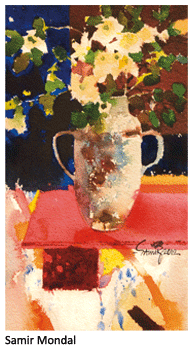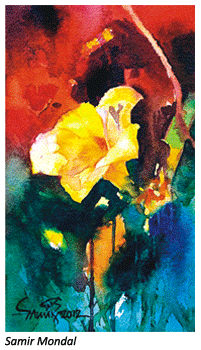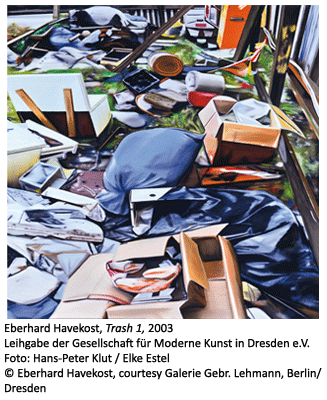- Publisher's Note
- Editorial
- Guerrilla Girls: The Masked Culture Jammers of the Art World
- Creating for Change: Creative Transformations in Willie Bester’s Art
- Radioactivists -The Mass Protest Through the Lens
- Broot Force
- Reza Aramesh: Action X, Denouncing!
- Revisiting Art Against Terrorism
- Outlining the Language of Dissent
- In the Summer of 1947
- Mapping the Conscience...
- 40s and Now: The Legacy of Protest in the Art of Bengal
- Two Poems
- The 'Best' Beast
- May 1968
- Transgressive Art as a Form of Protest
- Protest Art in China
- Provoke and Provoked: Ai Weiwei
- Personalities and Protest Art
- Occupy, Decolonize, Liberate, Unoccupy: Day 187
- Art Cries Out: The Website and Implications of Protest Art Across the World
- Reflections in the Magic Mirror: Andy Warhol and the American Dream
- Helmut Herzfeld: Photomontage Speaking the Language of Protests!
- When Protest Erupts into Imagery
- Ramkinkar Baij: An Indian Modernist from Bengal Revisited
- Searching and Finding Newer Frontiers
- Violence-Double Spread: From Private to the Public to the 'Life Systems'
- The Virasat-e-Khalsa: An Experiential Space
- Emile Gallé and Art Nouveau Glass
- Lekha Poddar: The Lady of the Arts
- CrossOver: Indo-Bangladesh Artists' Residency & Exhibition
- Interpreting Tagore
- Fu Baoshi Retrospective at The Metropolitan Museum of Art
- Random Strokes
- Sense and Sensibility
- Dragons Versus Snow Leopards
- What Happened and What's Forthcoming
- Art Events Kolkata, February – March 2012
- Mumbai Art Sighting
- Art Bengaluru
- Delhi Dias
- Musings from Chennai
- Preview, March, 2012 – April, 2012
- In the News, March 2012
- Cover
ART news & views
Mumbai Art Sighting
Issue No: 27 Month: 4 Year: 2012
by Jasmine Shah Varma
The other world
Sakti Burman’s The Wonder of It All opened in Mumbai on March 12th for a week long exhibition at the Jehangir Art Gallery. The tour of his retrospective collection was inaugurated in Delhi in February and travels to Kolkata in April and to Chennai in May of 2012.
 Around 150 works on canvas and paper and a few bronze sculptures were displayed in Mumbai with an attempt to cover the span of the 76 year old artist’s career from the 1960’s to the present day. While the Mumbai edition did seem partial to the works from the 1990’s and 2000 onwards, seeing the few examples from the previous decades gave a glimpse of the artist’s trajectory. Apparently the available exhibition space in Mumbai required editing of the original collection shown at the Lalit Kala Akademi, Delhi. In some of the 2011 works the joyfulmood and the atmosphere of reverie usually seen in Burman’s works were replaced by a serious concern for the present day world. In Song of the Lost Dream we see Mahatma Gandhi’s compassionate figure seated at the centre of the composition surrounded by violent gestures of individuals holding weapons. In another work the Gandhi figure is surrounded by motifs representing various religions. Considering Burman’s dominant preoccupation with characters from fantasy and mythology, it is interesting to see Gandhi in that context. Are Gandhi and his ideology starting to look like a myth in the 21st century?
Around 150 works on canvas and paper and a few bronze sculptures were displayed in Mumbai with an attempt to cover the span of the 76 year old artist’s career from the 1960’s to the present day. While the Mumbai edition did seem partial to the works from the 1990’s and 2000 onwards, seeing the few examples from the previous decades gave a glimpse of the artist’s trajectory. Apparently the available exhibition space in Mumbai required editing of the original collection shown at the Lalit Kala Akademi, Delhi. In some of the 2011 works the joyfulmood and the atmosphere of reverie usually seen in Burman’s works were replaced by a serious concern for the present day world. In Song of the Lost Dream we see Mahatma Gandhi’s compassionate figure seated at the centre of the composition surrounded by violent gestures of individuals holding weapons. In another work the Gandhi figure is surrounded by motifs representing various religions. Considering Burman’s dominant preoccupation with characters from fantasy and mythology, it is interesting to see Gandhi in that context. Are Gandhi and his ideology starting to look like a myth in the 21st century?
 The concept of afterlife, parallel universe or the dream world is central to majority of Burman’s work. Having lived in France for most of his life and travelled around, his references have been wide open. From Krishna Leela, narrative of Noah’s Ark to characters from Greek legends, Burman’s paintings are a world of his imagination. Works and subjects of other artists also inspire him as seen in Le Dejeuner au Taj Mahal, Hommage a Manet. This painting has the Taj Mahal in the background, a royal Mughal couple, and in the foreground a nude figure just like in Edouard Manet’s Le Dejeuner sur l’herbe. This clever juxtaposition of histories and legends in Burman’s painting evokes dialogue and intrigue. Often we see a father and son with a book, or young girls in bathing suits joyously running around in the garden. In some works it appears as if he is making a picture of a dream or is portraying a person narrating an ancient myth as seen the work titled Maite Writing the Stories of Durga and Noah’s Ark. Maite is his artist-wife. The collection also exhibited a few rare monochrome works in pastel on canvas without the stylized playful, decorative, colourful elements. These minimal works portray just figures in drawing and yet hold the viewer’s attention.
The concept of afterlife, parallel universe or the dream world is central to majority of Burman’s work. Having lived in France for most of his life and travelled around, his references have been wide open. From Krishna Leela, narrative of Noah’s Ark to characters from Greek legends, Burman’s paintings are a world of his imagination. Works and subjects of other artists also inspire him as seen in Le Dejeuner au Taj Mahal, Hommage a Manet. This painting has the Taj Mahal in the background, a royal Mughal couple, and in the foreground a nude figure just like in Edouard Manet’s Le Dejeuner sur l’herbe. This clever juxtaposition of histories and legends in Burman’s painting evokes dialogue and intrigue. Often we see a father and son with a book, or young girls in bathing suits joyously running around in the garden. In some works it appears as if he is making a picture of a dream or is portraying a person narrating an ancient myth as seen the work titled Maite Writing the Stories of Durga and Noah’s Ark. Maite is his artist-wife. The collection also exhibited a few rare monochrome works in pastel on canvas without the stylized playful, decorative, colourful elements. These minimal works portray just figures in drawing and yet hold the viewer’s attention.
The Wonder of It All summarized Burman’s inspirations and career, but as retrospectives go it would have done better with a chronological and structured approach to map out his career. Viewing so many works at one stretch does transport you into the other world or as the title of his painting says L’au Dela.
In bloom
Small format watercolour still life by Mumbai based Samir Mondal have been well-received at Jamaat Art Gallery. On the occasion of his 60th birthday on March 13th, he put up a collection of 60 works on paper titled 6 X 10. Keeping the occasion in mind all works are in dimensions of 6 x 10 inches. The exhibition is on view till April 30.


Mondal has gained reputation as a master watercolourist which is further reinforced by the body of work in this show. Till date he remains a staunch believer and practitioner of watercolours in spite of false hierarchies and apprehensions people have about the age-old medium. Size, large or small, is no restriction for him when it comes to handling the technique of transparent layering of water based pigments. For this show he has focused on the theme of flowers, vases, bouquets and scenic views of floral gardens. Capturing the play of light and vibrancy of hues from nature is Mondal’s forte. While some compositions capture a single flower in bloom others are a pleasant bunch celebrating form and an array of hues. From bright colour to pale shades, Mondal’s treatment can make a star out any hue he chooses. These works evoke a sense of joy, purity, exuberance and tenderness. The choice of this motif to celebrate his birthday calls to mind the symbolic association of flowers to germination and the cycle of life and death. It is indeed a joy to see the marriage of beauty and skill in these celebratory works of art.
Universal urban chaos
 A major exhibition of a leading German artist, Sightseeing Trip took place at the Bhau Daji Lad Museum from February 19 to April 1. This is a first time collaboration between Germany’s museum the Dresden State Art Collections and an Indian museum to bring contemporary works to India and is part of the Indo-German friendship year series of events.The exhibition is travelling to the renovated Durbar Hall in Kochi later this year following an invitation from the Kochi Biennale Foundation. Havekost, born in 1967, works in oil on canvas and digital photographs that capture the urban culture of chaos, architecture displaying development in the globalised world, transport and communication systems that have quickened the pace of life, the use and throw tendency in contemporary lifestyle and,the people inhabiting modern cities.Havekost portrays snapshots of commonplace, often unnoticed scenes from streets, objects in public places, view from a window, trash, vehicles, graffiti, hoarding imagery and so on. The images for the paintings are sourced from his own photography. He chooses to paint just a portion of a scene or an object, an abstraction of the whole, a skewed view to depict an essence of the urban disharmony. His attempt is to portray an essence of the city the way the human eye perceives it, not how a photograph or media would capture it. The bright, glossy, colour palette, and the cropped imagery evoke energy, in spite of the choice of humdrum scenes like the bonnet of a car or garbage. He has created his own style to interpret his themes. It is neither photorealism nor is it realistic in the classical sense.
A major exhibition of a leading German artist, Sightseeing Trip took place at the Bhau Daji Lad Museum from February 19 to April 1. This is a first time collaboration between Germany’s museum the Dresden State Art Collections and an Indian museum to bring contemporary works to India and is part of the Indo-German friendship year series of events.The exhibition is travelling to the renovated Durbar Hall in Kochi later this year following an invitation from the Kochi Biennale Foundation. Havekost, born in 1967, works in oil on canvas and digital photographs that capture the urban culture of chaos, architecture displaying development in the globalised world, transport and communication systems that have quickened the pace of life, the use and throw tendency in contemporary lifestyle and,the people inhabiting modern cities.Havekost portrays snapshots of commonplace, often unnoticed scenes from streets, objects in public places, view from a window, trash, vehicles, graffiti, hoarding imagery and so on. The images for the paintings are sourced from his own photography. He chooses to paint just a portion of a scene or an object, an abstraction of the whole, a skewed view to depict an essence of the urban disharmony. His attempt is to portray an essence of the city the way the human eye perceives it, not how a photograph or media would capture it. The bright, glossy, colour palette, and the cropped imagery evoke energy, in spite of the choice of humdrum scenes like the bonnet of a car or garbage. He has created his own style to interpret his themes. It is neither photorealism nor is it realistic in the classical sense.
Seeing his pictures what strikes is that chaos and frenzy of an urban city in Germany or in India are universal. The effects on the psyche of the individuals and society at large too are not different.